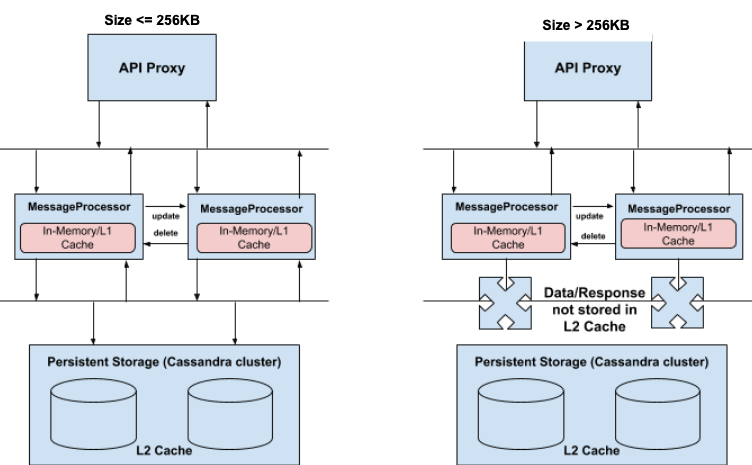您正在查看 Apigee 和 Apigee Hybrid 說明文件。
查看
Apigee Edge 說明文件。
Apigee 可在執行階段將資料儲存在快取中,以便持續存在並加快擷取速度。
- 資料一開始會儲存在訊息處理器的記憶體內快取中,也就是 L1 快取。
- L1 快取的限制取決於為其保留的記憶體量,以 JVM 記憶體的百分比表示。
- 快取的項目稍後會保留在 L2 快取中,所有訊息處理器都可以存取。詳情請參閱下文。
- L2 快取對快取項目數量沒有任何硬性限制,但可快取的項目最大大小則限制為 256 KB。為達到最佳效能,建議使用 256 KB 的快取大小。
反模式
這個反模式會說明超出 Apigee 目前快取大小限制的影響。
快取的資料大於 256 KB 時,會導致以下後果:
- 在每個訊息處理器上首次執行的 API 要求,需要從原始來源 (政策或目標伺服器) 獨立取得資料,因為 L2 快取中沒有大於 256 KB 的項目。
- 在 L1 快取中儲存較大的資料 (大於 256 KB) 會對平台資源造成更大的壓力。這會導致 L1 快取記憶體更快地被填滿,因此可用於其他資料的空間會變少。因此,您無法盡可能積極地快取資料。
- 當達到項目數量上限時,系統就會移除 Message Processor 中的快取項目。這會導致在各個訊息處理器上再次從原始來源擷取資料。

影響
- 大小超過 256 KB 的資料不會儲存在 L2/永久快取中。
- 呼叫原始來源 (政策或目標伺服器) 的頻率越高,API 要求的延遲時間就會越長。
最佳做法
- 建議您將大小小於 256 KB 的資料儲存在快取中,以獲得最佳效能。
- 如果需要儲存的資料大於 256 KB,請考慮以下做法:
- 使用任何適當的資料庫儲存大量資料
OR
- 壓縮資料
- 使用任何適當的資料庫儲存大量資料

